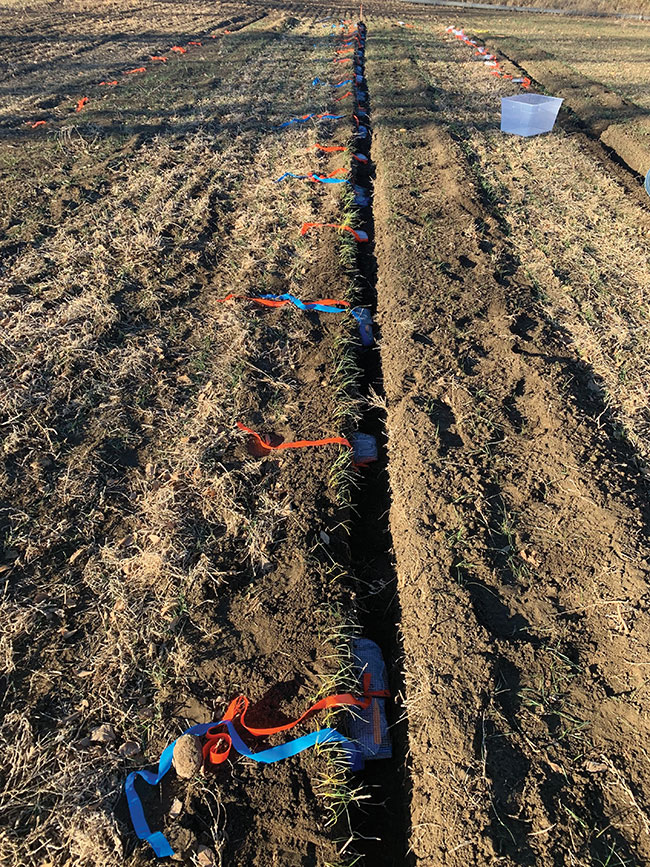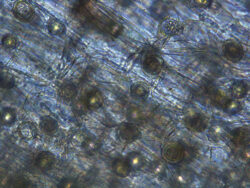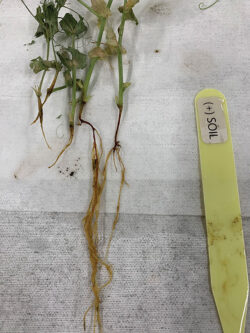
Features
Diseases
Pulses
Quantifying Aphanomyces severity in pea and lentil
Survival of oospores of Aphanomyces euteiches in soil environments.
April 17, 2023 By Donna Fleury
 Setting up field cage experiments to quantify Aphanomyces oospore levels.
Photo COURTESY OF SYAMA CHATTERTON.
Setting up field cage experiments to quantify Aphanomyces oospore levels.
Photo COURTESY OF SYAMA CHATTERTON. Aphanomyces root rot is a serious economic disease for pea and lentil crops across the Prairies. This disease, caused by the highly specialized pathogen Aphanomyces euteiches, persists as resting spores or oospores that are considered the primary drivers of disease. Researchers continue to advance research and management strategies, including quantification of oospores in the soil to help facilitate disease prediction.
“For researchers and producers, Aphanomyces root rot continues to present a lot of challenges and we remain focused on developing additional management tools beyond longer-term rotations,” says Syama Chatterton, plant pathologist with Agriculture and Agri-Food Canada in Lethbridge, Alta. “The presence of Aphanomyces disease continued in 2022, even though conditions in southern Alberta and some other locations in 2022 started out really dry. However, an intense period of rain in June really set off the disease. Although we didn’t get much more rain during the growing season, that rain at the right time of the year set up perfect conditions for Aphanomyces.
“We actually saw a fair amount of disease in southern Alberta, and surprisingly even in lentils which we don’t usually see because conditions have been dry,” adds Chatterton. “Other parts of Alberta and Saskatchewan had similar weather patterns and disease conditions, although central Alberta was quite wet over the growing season. There were lots of ups and downs in 2022, but the disease continues to persist in pea and lentil fields in many areas.”
To better quantify oospores and understand their survival in soil environments, Chatterton initiated a new project in 2021. The main objective of this project is to develop a method for differentiating between viable and nonviable oospores in soil and/or quantify inoculum potential in soil. A second objective is to determine the effect of extreme soil temperatures and moisture on oospore survival, molecular quantification, and lentil and pea susceptibility. The ultimate goal of trying to quantify oospores in soil would give producers an idea of what the expected disease severity would be in a field.

Oospores on pea roots.
Photo courtesy of Syama Chatterton.
“The first experiments were conducted in the lab using different techniques to determine if we could differentiate between viable and non-viable oospores,” says Chatterton. “We used different staining techniques and also looked at DNA based techniques. The idea is that in the experiments, the dead spores would take up the stain or chemical that prevents DNA amplification, allowing us to tell the difference between viable and non-viable oospores. Unfortunately, neither technique worked very well and it was very difficult to determine any differences. The oospores are challenging to work with given they have very thick cell walls, and even the dead oospores were very good at preventing anything getting inside the cells. These same techniques have been used with clubroot spores, where the results were likely better because clubroot spores are more delicate compared to the thick walled Aphanomyces oospores.”
For now, researchers continue to rely on a microscope to differentiate between live and dead oospores. Live oospores under the microscope look dense and granulated, while the dead oospores look empty. However, researchers noted that the problem with this strategy is that it only works with oospores prepared fresh in the lab. Trying to use oospores collected from plant roots or soil does not provide a clear picture for differentiation under the microscope.
“In November 2021, we started the second phase of the project at one field location in Lethbridge,” says Chatterton. “Oospores were buried on plant roots or in the soil in cages, and every three months samples were assessed to quantify oospore levels.”
The researchers are using an indirect assessment method through plant bioassays, rather than trying to quantify the oospore levels directly. “Peas are planted into the soil samples collected and then disease severity is assessed on the plants once they grow. This provides an indirect assessment of the viability of oospores in the soil and an idea of expected disease severity. This will provide an indication of how quickly these oospores are decaying in the soil and how quickly their disease-causing potential is being reduced.”
The results from the first year of the study have not shown a reduction in disease potential so far. Chatterton notes that it shows the inoculum potential has not decreased over one year, but she wants to see if that changes over the next two years. Samples were taken again at the end of November 2022 and will continue every three months until the end of the project. These experiments are only being conducted at one location for now to determine if the technique and methods to track the disease will work. If the results are successful, then Chatterton plans to expand the study into other areas to assess whether differences in environments or soil types impacts how oospores are decaying in the field.
“We are also conducting another controlled environment study in the lab to determine the effect of extreme soil temperatures and moisture on oospore survival,” adds Chatterton. “We have several kilograms of soil divided into different samples. The samples are inoculated with different levels of oospores that will be tracked over time. The samples will be incubated at a range of different temperatures and moisture conditions. The results will show whether the range of temperatures, including colder temperatures similar to Prairie winter conditions, impact oospore survival and levels.”

Plant bioassay showing pea roots grown on Aphanomyces infected soil that was buried for nine months.
Photo COURTESY OF Syama Chatterton.
Chatterton says this is a tricky organism to work with. “For example, we sometimes have a hard time keeping the Aphanomyces cultures alive in the lab, but they survive quite well out in the field. There are still a lot of unknowns about oospores and unanswered technical questions about spore structure, cell wall content, biochemistry and what makes the oospores so resilient in the field. We just don’t have all of those answers yet.”
Today, the key management strategy for growers is to continue to follow a longer-term rotation of six to eight years for field peas and lentils in fields that are known to have Aphanomyces disease. Growers can also have soils tested from fields that are being considered for rotation back into peas and lentils that are known to have a problem. Chatterton and her collaborators have evaluated different chemical and biological seed treatments for a number of years, but so far haven’t found anything that is working really well in the field. Aphanomyces has a very specific host range in pulse crops or legumes, with field pea and lentil being the most susceptible. It has been found in alfalfa and other legumes used for forage or cover crops and other host plants such as chickweed and shepherd’s purse can serve as an alternate source of inoculum. Other pulse crops, such as faba beans, chickpeas and soybeans, are tolerant or resistant to Aphanomyces.
“Through this project, our end goal is to try to determine an oospore decay rate and figure out how long it will take to reduce oospore levels below the threshold,” says Chatterton. “Hopefully we will be able to expand these experiments to other locations to get a better understanding of how the decay rate might change in different soils and environmental conditions. At the same time, we are continuing to refine techniques for quantifying oospores from the soil, it hasn’t been a perfect science. Hopefully by the end of the project, we will have a better understanding of oospore survival and expected disease severity.”